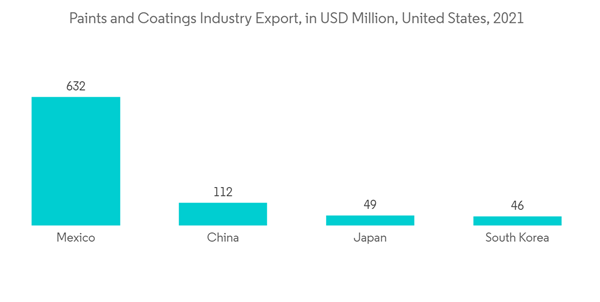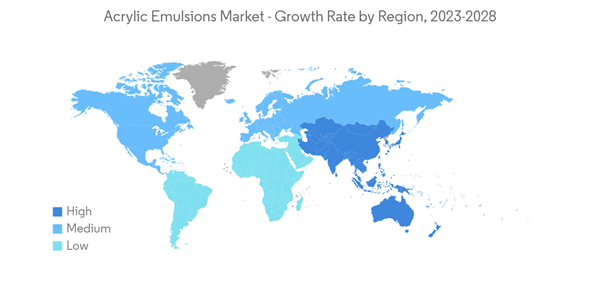The market for acrylic emulsions is expected to register at a CAGR of over 5% during the forecast period.
COVID-19 negatively impacted the market as all the industries halted their manufacturing processes. Lockdowns, social distances, and trade sanctions triggered massive disruptions to global supply chain networks. The construction industry witnessed a decline due to the halt in activities. However, the condition recovered in 2021 is expected to benefit the market during the forecast period.
This product will be delivered within 2 business days.
COVID-19 negatively impacted the market as all the industries halted their manufacturing processes. Lockdowns, social distances, and trade sanctions triggered massive disruptions to global supply chain networks. The construction industry witnessed a decline due to the halt in activities. However, the condition recovered in 2021 is expected to benefit the market during the forecast period.
Key Highlights
- The major factors driving the market studied are the growing demand for water-based paints. It is due to the rising input costs for solvent-based paints.
- However, the growing preference for polyurethane in coating applications is expected to restrain the market growth.
- Growth and expansion of buildings and construction industry and increasing awareness about the benefits of acrylic emulsions technique act as opportunities for market growth.
- Asia-Pacific is expected to dominate the global market due to rapid urbanization and industrialization, leading to a massive demand for acrylic emulsions from countries such as China, Japan, and India.
Acrylic Emulsions Market Trends
Paints and Coatings Application to Dominate the Market
- Acrylic polymer emulsions are used for various benefits such as UV resistance, elongation balance, water resistance, good adhesion, and many others.
- One of the significant applications of acrylic emulsions is in making architectural and industrial coatings owing to factors like low VOC emissions, easy handling, and high performance in water-borne layers.
- According to the American Coatings Association, paints and coatings lead the worldwide demand for Polymer Emulsions, which accounted for USD 15 billion in 2021. It is further projected to reach USD 22.6 billion by 2027. In 2021, the United States exported USD 2.5 billion in paint and coatings products.
- Acrylic emulsion possesses excellent adhesive and waterproofing properties, so it is extensively used in the construction industry for various purposes. According to the US Census Bureau, in December 2021, construction spending in the country was estimated at a seasonally adjusted annual rate of USD 1,639.9 billion. In 2022, the completed authorized privately-owned housing units reached 16,647 thousand in the United States.
- The increasing global population increases the consumption of residential buildings, enhancing the demand for polymer emulsions to be used in paints and coatings. According to the United Nations Department of Economic and Social Affairs, the global population reached 8 billion in November 2022 and is estimated to grow to around 8.5 billion by 2030, 9.7 billion in 2050, and 10.4 billion in 2100.
- Water-based paints and coatings are recently adopted due to their high durability, less odor, and low VOC emissions. Water-based paints and coatings account for around 80% of total colors sold in the residential coatings sector.
- Hence, paints and coatings application is expected to continue dominating the market during the forecast period.
Asia-Pacific Region to Witness a Major Growth Rate
- Increasing demand for building and construction in China and India resulted in Asia-Pacific’s domination over the global acrylic emulsions market.
- Due to fast industrialization and rising construction and building activities in nations including India, Japan, Singapore, & Malaysia, Asia-Pacific is expected to be the most appealing market over the projected timeframe.
- For instance, the Indian government will likely invest around USD 1.3 trillion in housing over the next seven years. The government will likely construct 60 million new homes, boosting the acrylic emulsions market.
- China is experiencing massive growth in its construction sector. According to the National Bureau of Statistics of China, in 2021, the construction output in China was valued at approximately USD 4.29 trillion.
- Increasing construction activities worldwide impact the demand for acrylic emulsions in paints and coatings. China planned to invest USD 1.43 trillion by 2025 in significant construction projects. According to National Development and Reform Commission (NDRC), the Shanghai plan includes an investment of USD 38.7 billion in the next three years, whereas Guangzhou signed 16 new infrastructure projects with an investment of USD 8.09 billion.
- In 2022, India contributed about USD 640 billion to the construction industry due to government initiatives in infrastructure development and affordable housing, such as housing to all, smart city plans, and others. The growing construction activities in the country are driving the demand for paint and coatings, which, in turn, may drive the acrylic emulsions market over the forecast period.
- The commercial and residential construction industries are witnessing growth in the ASEAN countries owing to the increasing investment by government and private organizations.
- Due to these factors, Asia-Pacific will likely witness a significant growth rate during the forecast period.
Acrylic Emulsions Industry Overview
The acrylic emulsions market is moderately consolidated, with a few players occupying a significant market share. Some key players include BASF SE, Dow., Arkema Group, Celanese Corporation, and DIC CORPORATION.Additional Benefits:
- The market estimate (ME) sheet in Excel format
- 3 months of analyst support
This product will be delivered within 2 business days.
Table of Contents
1 INTRODUCTION1.1 Study Deliverables
1.2 Study Assumptions
1.3 Scope of the Study
2 RESEARCH METHODOLOGY
3 EXECUTIVE SUMMARY
4 MARKET DYNAMICS
4.1 Drivers
4.1.1 Increasing Demand for Water-Based Paints
4.1.2 Growing Investment in Asia-Pacific Construction Industry
4.2 Restraints
4.2.1 Growing Preference for Polyurethane Dispersions in Coating Applications
4.3 Industry Value-Chain Analysis
4.4 Porter's Five Forces Analysis
4.4.1 Bargaining Power of Suppliers
4.4.2 Bargaining Power of Consumers
4.4.3 Threat of New Entrants
4.4.4 Threat of Substitute Products and Services
4.4.5 Degree of Competition
5 MARKET SEGMENTATION
5.1 Type
5.1.1 Pure Acrylic Emulsions
5.1.2 Styrene Acrylic Emulsions
5.1.3 Vinyl Acrylic Emulsions
5.2 Application
5.2.1 Paints and Coatings
5.2.2 Construction Material Additives
5.2.3 Paper Coating
5.2.4 Adhesives
5.2.5 Other Applications
5.3 Geography
5.3.1 Asia-Pacific
5.3.1.1 China
5.3.1.2 India
5.3.1.3 Japan
5.3.1.4 South Korea
5.3.1.5 Australia & New Zealand
5.3.1.6 Rest of Asia-Pacific
5.3.2 North America
5.3.2.1 United States
5.3.2.2 Canada
5.3.2.3 Mexico
5.3.3 Europe
5.3.3.1 Germany
5.3.3.2 United Kingdom
5.3.3.3 Italy
5.3.3.4 France
5.3.3.5 Russia
5.3.3.6 Rest of Europe
5.3.4 South America
5.3.4.1 Brazil
5.3.4.2 Argentina
5.3.4.3 Rest of South America
5.3.5 Middle East & Africa
5.3.5.1 Saudi Arabia
5.3.5.2 South Africa
5.3.5.3 Rest of Middle East & Africa
6 COMPETITIVE LANDSCAPE
6.1 Mergers and Acquisitions, Joint Ventures, Collaborations, and Agreements
6.2 Market Share (%) Analysis**/Ranking Analysis
6.3 Strategies Adopted by Leading Players
6.4 Company Profiles
6.4.1 3M
6.4.2 Arkema Group
6.4.3 BASF SE
6.4.4 Celanese Corporation
6.4.5 DIC Corporation
6.4.6 Dow
6.4.7 Gellner Industrial LLC
6.4.8 Mallard Creek Polymers
6.4.9 Pexi Chem Private Limited
6.4.10 Royal DSM NV
6.4.11 Synthomer plc
6.4.12 The Cary Company
6.4.13 The Lubrizol Corporation
7 MARKET OPPORTUNITIES AND FUTURE TRENDS
7.1 Advancements in Self-crosslinking Technology of Acrylic Emulsion
Companies Mentioned (Partial List)
A selection of companies mentioned in this report includes, but is not limited to:
- 3M
- Arkema Group
- BASF SE
- Celanese Corporation
- DIC Corporation
- Dow
- Gellner Industrial LLC
- Mallard Creek Polymers
- Pexi Chem Private Limited
- Royal DSM NV
- Synthomer plc
- The Cary Company
- The Lubrizol Corporation
Methodology

LOADING...










